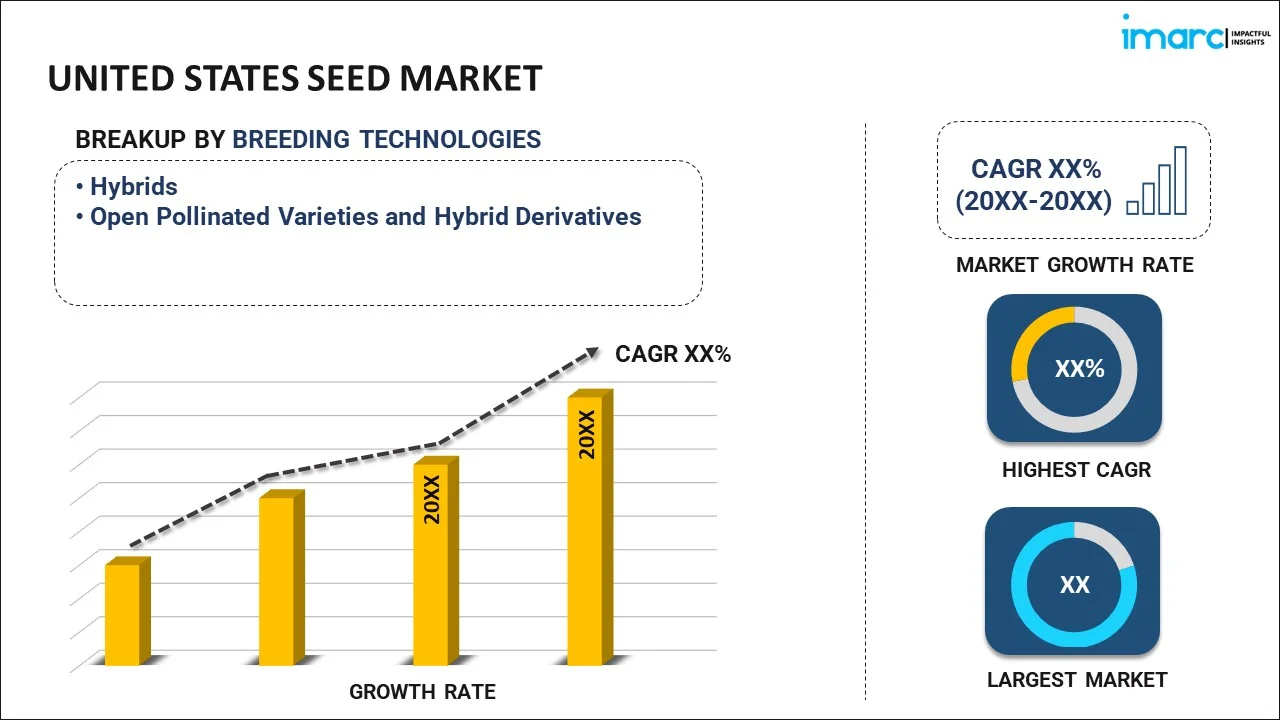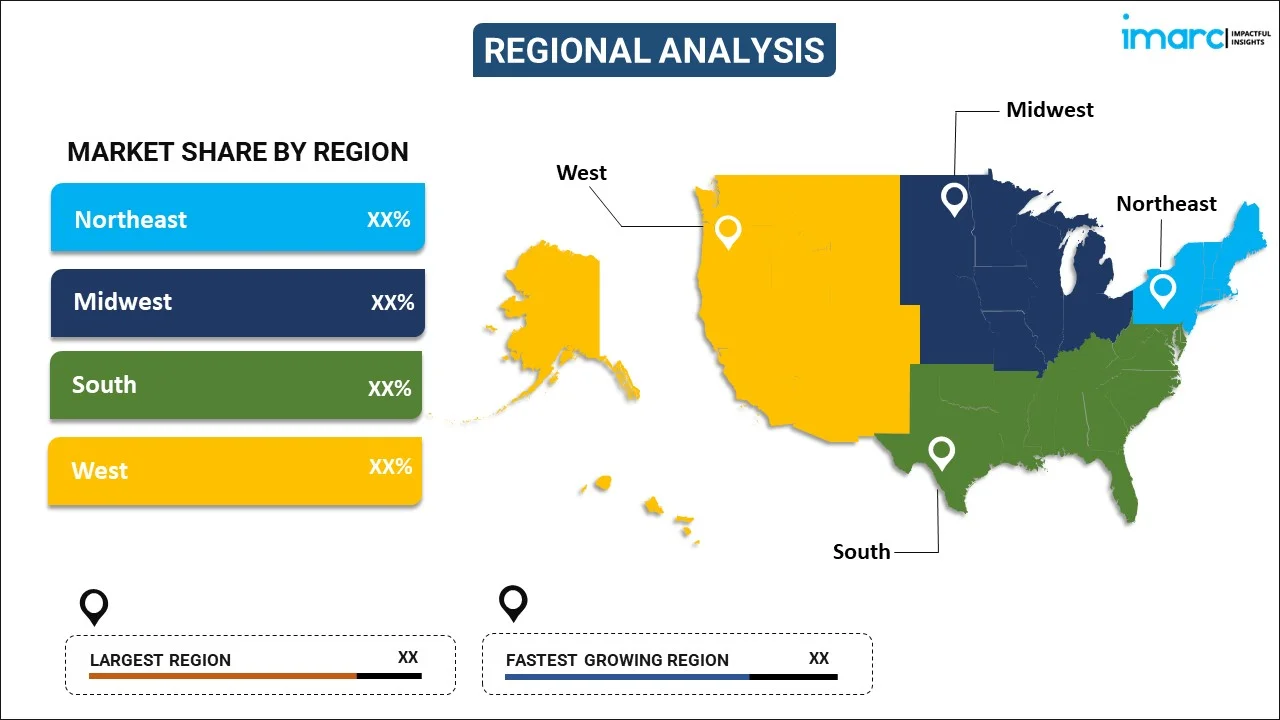
United States Seed Market Report by Breeding Technology (Hybrids, Open Pollinated Varieties and Hybrid Derivatives), Cultivation Mechanism (Open Field, Protected Cultivation), Crop Type (Row Crops, Vegetables), and Region 2025-2033
Market Overview:
United States seed market size is projected to exhibit a growth rate (CAGR) of 6.62% during 2025-2033. The ongoing R&D efforts, which lead to the creation of new seed varieties with improved traits, such as drought tolerance, enhanced nutritional content, and better adaptability to specific climates, are driving the market.
|
Report Attribute
|
Key Statistics
|
|---|---|
|
Base Year
|
2024 |
|
Forecast Years
|
2025-2033
|
|
Historical Years
|
2019-2024
|
| Market Growth Rate (2025-2033) | 6.62% |
A seed is a vital, embryonic plant enclosed in a protective coat, typically found within the ovule of a flowering plant. It serves as the reproductive unit of plants, facilitating the continuity of their species. Seeds contain genetic information essential for the development of a new plant, encompassing traits inherited from both parent plants. This genetic diversity contributes to the adaptability and evolution of plant species over time. Seeds are characterized by their ability to remain dormant until conditions are favorable for germination, ensuring survival during adverse environmental conditions. They embody the promise of life, encapsulating the potential for growth, resilience, and regeneration. Human cultivation and consumption of seeds, particularly in agriculture, play a crucial role in sustaining food sources, making seeds a cornerstone of biodiversity, ecological balance, and agricultural practices.
United States Seed Market Trends:
The seed market in the United States is propelled by several key drivers, fostering its growth and evolution. Firstly, the increasing regional population necessitates a parallel surge in food production, driving demand for high-yielding and resilient seeds. Moreover, advancements in biotechnology have revolutionized seed development, enabling the creation of genetically modified organisms (GMOs) that exhibit enhanced traits such as pest resistance and higher nutritional content. Additionally, climate change poses a significant challenge to traditional agricultural practices, prompting a shift towards the adoption of climate-resilient seeds that can thrive in diverse environmental conditions. Furthermore, the expanding awareness and emphasis on sustainable agriculture practices drive the demand for seeds that promote ecological balance, reduce environmental impact, and enhance soil fertility. Collaborative research initiatives between the public and private sectors also play a pivotal role in driving innovation in seed technology. The growing trend towards precision agriculture, facilitated by the integration of digital technologies, further boosts the demand for precision seeds tailored to specific agroecological zones. In conclusion, a confluence of factors, including population growth, technological advancements, climate change considerations, sustainability concerns, and collaborative research efforts, collectively propels the dynamic landscape of the regional seed market.
United States Seed Market Segmentation:
IMARC Group provides an analysis of the key trends in each segment of the market, along with forecasts at the country level for 2025-2033. Our report has categorized the market based on breeding technology, cultivation mechanism, and crop type.
Breeding Technology Insights:

- Hybrids
- Non-Transgenic Hybrids
- Transgenic Hybrids
- Herbicide Tolerant
- Insect Resistant
- Others
- Open Pollinated Varieties and Hybrid Derivatives
The report has provided a detailed breakup and analysis of the market based on the breeding technology. This includes hybrids [non-transgenic hybrids and transgenic hybrids (herbicide tolerant, insect resistant, and others)] and open pollinated varieties and hybrid derivatives.
Cultivation Mechanism Insights:
- Open Field
- Protected Cultivation
A detailed breakup and analysis of the market based on the cultivation mechanism have also been provided in the report. This includes open field and protected cultivation.
Crop Type Insights:
- Row Crops
- Fiber Crops
- Cotton
- Others
- Forage Crops
- Alfalfa
- Forage Corn
- Forage Sorghum
- Others
- Grains and Cereals
- Corn
- Rice
- Sorghum
- Wheat
- Others
- Oilseeds
- Canola, Rapeseed and Mustard
- Soybean
- Sunflower
- Others
- Pulses
- Fiber Crops
- Vegetables
- Brassicas
- Cabbage
- Carrot
- Cauliflower and Broccoli
- Others
- Cucurbits
- Cucumber and Gherkin
- Pumpkin and Squash
- Others
- Roots and Bulbs
- Garlic
- Onion
- Potato
- Others
- Solanaceae
- Chilli
- Eggplant
- Tomato
- Others
- Unclassified Vegetables
- Asparagus
- Lettuce
- Okra
- Peas
- Spinach
- Others
- Brassicas
The report has provided a detailed breakup and analysis of the market based on the crop type. This includes row crops [fiber crops (cotton and others), forage crops (alfalfa, forage corn, forage sorghum, and others), grains and cereals (corn, rice, sorghum, wheat, and others), oilseeds (canola, rapeseed and mustard, soybean, sunflower, and others), and pulses and vegetables [brassicas (cabbage, carrot, cauliflower and broccoli, and others), cucurbits (cucumber and gherkin, pumpkin and squash, and others), roots and bulbs (garlic, onion, potato, and others), solanaceae (chilli, eggplant, tomato, and others), and unclassified vegetables (asparagus, lettuce, okra, peas, spinach, and others)].
Regional Insights:

- Northeast
- Midwest
- South
- West
The report has also provided a comprehensive analysis of all the major regional markets, which include Northeast, Midwest, South, and West.
Competitive Landscape:
The market research report has also provided a comprehensive analysis of the competitive landscape in the market. Competitive analysis such as market structure, key player positioning, top winning strategies, competitive dashboard, and company evaluation quadrant has been covered in the report. Also, detailed profiles of all major companies have been provided.
United States Seed Market Report Coverage:
| Report Features | Details |
|---|---|
| Base Year of the Analysis | 2024 |
| Historical Period | 2019-2024 |
| Forecast Period | 2025-2033 |
| Units | Billion USD |
| Scope of the Report | Exploration of Historical and Forecast Trends, Industry Catalysts and Challenges, Segment-Wise Historical and Predictive Market Assessment:
|
| Breeding Technologies Covered |
|
| Cultivation Mechanisms Covered | Open Field, Protected Cultivation |
| Crop Types Covered |
|
| Regions Covered | Northeast, Midwest, South, West |
| Customization Scope | 10% Free Customization |
| Post-Sale Analyst Support | 10-12 Weeks |
| Delivery Format | PDF and Excel through Email (We can also provide the editable version of the report in PPT/Word format on special request) |
Key Questions Answered in This Report:
- How has the United States seed market performed so far and how will it perform in the coming years?
- What has been the impact of COVID-19 on the United States seed market?
- What is the breakup of the United States seed market on the basis of breeding technology?
- What is the breakup of the United States seed market on the basis of cultivation mechanism?
- What is the breakup of the United States seed market on the basis of crop type?
- What are the various stages in the value chain of the United States seed market?
- What are the key driving factors and challenges in the United States seed?
- What is the structure of the United States seed market and who are the key players?
- What is the degree of competition in the United States seed market?
Key Benefits for Stakeholders:
- IMARC’s industry report offers a comprehensive quantitative analysis of various market segments, historical and current market trends, market forecasts, and dynamics of the United States seed market from 2019-2033.
- The research report provides the latest information on the market drivers, challenges, and opportunities in the United States seed market.
- Porter's five forces analysis assist stakeholders in assessing the impact of new entrants, competitive rivalry, supplier power, buyer power, and the threat of substitution. It helps stakeholders to analyze the level of competition within the United States seed industry and its attractiveness.
- Competitive landscape allows stakeholders to understand their competitive environment and provides an insight into the current positions of key players in the market.
Need more help?
- Speak to our experienced analysts for insights on the current market scenarios.
- Include additional segments and countries to customize the report as per your requirement.
- Gain an unparalleled competitive advantage in your domain by understanding how to utilize the report and positively impacting your operations and revenue.
- For further assistance, please connect with our analysts.
 Inquire Before Buying
Inquire Before Buying
 Speak to an Analyst
Speak to an Analyst
 Request Brochure
Request Brochure
 Request Customization
Request Customization




.webp)




.webp)












